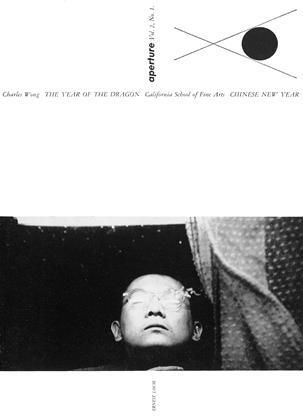California School of Fine Arts / CHINESE NEW YEAR
In the century ahead the peoples of the world have to learn to live together. Cultures and races have to learn to live side by side, influencing one another rather than engaging in a struggle to overwhelm one another. This is a job no world would choose for itself and accept only because there is no alternative.
• Fortunately there are examples of cultural neighbors. Some examples are local such as the meeting ground of a Cantonese culture and an American one in San Francisco's China Town. This is a little island of an aesthetic-philosophical culture surrounded by a continent of a technological-legalistic culture. The two are very different. When the Chinese first started trickling in like drops of water falling on a blotter, they were met with distrust and hostility. In self defense the Chinese community developed its own ruling bodies to settle its internal disputes rather than go to the Western courts. It wore the traditional clothes, pursued its own old customs, policed its own people, established and maintained the Chinese schools that the youngsters still attend after a day at the city public schools. It slowly took on the Western holidays, the Western washing machines, and lately, bobby sox and Levis: yet it still looks forward to its oivn New Year and its joy with firecrackers.
• With such a tiny island hardly any other end is possible than that the Eastern culture will be diluted till it disintegrates. The present generation wish it this way: and the wonderful thing is that the vitality of the young men and women does not disappear with the forgetting of the traditional culture but is vitally transferred to the culture that has become their birthright.
• Meanwhile the clash of cultures goes on as if in a showcase.
• For the Chinese, New Years time has always been the season of gayest celebration. It arrives with the second moon after the winter solstice and is greeted with weeks of festivity.
• This is the time offamily reunion, of flowers in the house and special good things to eat.
• The people try to pay their debts before the New Year comes and to have everything clean. Their hearts cast off the burdens of the dying year and remind them that a new chance for luck and happiness is at hand.
• Poems are written on fresh red scrolls and hung in the windows along the street.
• At New Year families dress in new clothes and pay calls on their friends. Presents are given and there are oranges and red powers in every house.
• On the second or third day of the celebration, the lion's music is heard up and down the streets; a music of firecrackers, cymbals and drums. The merchants string up their gifts of money and food. When the boys arrive wearing the great lion masks, the storekeeper tosses lighted firecrackers under their feet. The lions dance in and out and about the doorway, and take the money for the Chinese hospital. Before the house of a benevolent association or other important donor, the lion dancers give a long special performance learned from an ancient tradition.
• All the days and nights of the holiday, the air crackles with light-hearted explosions of gunpowder. 'Vhe old men look pleased. The faces of the children being led and carried through the crowds are round and shiny with the happiness of the time.
• The year begins smiling.
• f ¡ere we cun see one culture, in this cuse the Western one. ubsorb unother. As the third generation says, ' ' we wish to be America ns" and sometimes oppose their parents u ho manage to harmonize their American leaves with their Chinese roots.
• /Most of all your wants are like ours, we all want to be human beings, loved and loving, respected and respectful, admired and admiring.





















